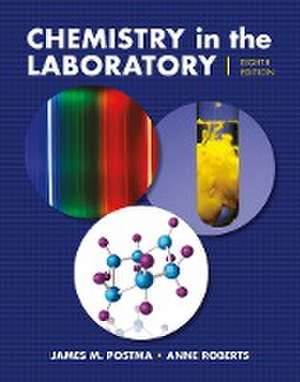Chemistry in the Laboratory
Autor James M. Postma, Julian L. Roberts, Ann Robertsen Limba Engleză Spirală
Preț: 448.29 lei
Preț vechi: 669.07 lei
-33% Nou
85.79€ • 93.16$ • 72.06£
Carte indisponibilă temporar
Specificații
ISBN-10: 1319032524
Pagini: 624
Dimensiuni: 211 x 267 x 36 mm
Greutate: 1.45 kg
Ediția:8
Notă biografică
Cuprins
Preface
First-Day Instructions
Welcome to the Chemistry Lab
Introduction
Experiment 1
Scientific Measurements
Experiment 2
Mass and Volume Relationships
Experiment 3
Forensic Chemistry: Crime Scene Investigation
Experiment 4
Observing the Reactions of Household Chemicals
Deductive Chemical Reasoning
Experiment 5
A Cycle of Copper Reactions
Experiment 6
Synthesis of a Chemical Compound: Making Alum from Aluminum
Experiment 7
The Chemistry of Oxygen: Basic and Acidic Oxides and the Periodic Table
Experiment 8
Determination of a Chemical Formula
The Reaction of Iodine with Zinc
Experiment 9
Determination of a Chemical Formula by Titration
The Reaction of Calcium with Water
Study Assignment A
The Language of Chemistry: Chemical Nomenclature
Experiment10
The Estimation of Avogadro’s Number
Experiment 11
The Molar Volume of Dioxygen and Other Gases
Experiment 12
The Molar Mass of a Gas
A Reduced Scale Method
Experiment 13
The Reactivity of Metals with Hydrochloric Acid
Experiment 14
The Heat Capacity of Metals
Experiment15
Enthalpy Changes in Chemical Reactions
Hess’s Law
Experiment 16
The Enthalpy of Combustion of a Vegetable Oil
Experiment17
Emission Spectra and the Electronic Structure of Atoms
The Hydrogen Atom Spectrum
Experiment 18
Ionic and Covalent Bonding
Conductivity of Solutions of Ionic and Covalent Compounds
Study Assignment B
Writing Lewis Structures
Experiment 19
Models of Molecular Shapes
VSEPR Theory and Orbital Hybridization
Experiment 20
How much food dye is in your drink?
A Spectrophotometric Analysis
Experiment 21
Intermolecular Forces
Slime Gel: Making and Killing Slime
Experiment 22
Liquids and Solids
The Vapor Pressure and Enthalpy of Vaporization of Water
The Enthalpy of Fusion of Water
Experiment 23
Colligative Properties
The Molar Mass of a Soluble Substance by Freezing-Point Depression
Experiment 24
Some Examples of Chemical Equilibria
Le Chậtelier’s Principle
Experiment 25
Determination of an Equilibrium Constant by Spectrophotometry
The Iron(III)-Thiocyanate Complex Ion
Experiment 26
Factors Affecting the Rates of Chemical Reactions
Experiment 27
The Rate of a Chemical Reaction
Chemical Kinetics
Experiment 28
The pH Scale and Acid-Base Titrations
Standardization of NaOH Solution
The Titration of Vinegar and Stomach Antacids
Experiment 29
Determination of the Molar Mass and Ionization Constant of a Weak Acid
Experiment 30
Preparing and Exploring the Properties of Buffers
Experiment 31
What’s in Your Drinking Water?
Comparing Tap and Bottled Water
Experiment 32
The Solubility Product Constant of Calcium Iodate, Ca(IO3)2
Experiment 33
Identification of the Alkaline Earth and Alkali Metal Ions
Analysis of Cations in Seawater
Experiment 34
The Qualitative Analysis of Some Common Anions
Analysis of Anions in Seawater
Experiment 35
An Introduction to Green Chemistry
Making Biodiesel and Soap from Vegetable Oils and Fats
Experiment 36
Oxidation-Reduction
Electron Transfer Reactions
Experiment 37
Redox Titrations
The Oxidizing Capacity of a Household Cleanser or Liquid Bleach
Experiment 38
Electrochemical Cells
Experiment 39
Electrochemical Puzzles
Metal Corrosion and Anodic Protection
The Golden Penny Experiment
Experiment 40
The Chemistry of Some Nonmetals: Nitrogen, Sulfur, and Chlorine
Experiment 41
Equilibria of Coordination Compounds
Experiment 42
Environmental Aspects of Carbon Dioxide Reactivity
Experiment 43
Natural Radioactivity
The Half-Life of Potassium-40 in Potassium Chloride
Appendix: Tables of Data
Table 1. The International System (SI) of Units and Conversion Factors
Table 2. Fundamental Physical and Mathematical Constants
Table 3. Vapor Pressure of Water at Different Temperatures
Table 4. Concentration of Desk Acid and Base Solutions
Table 5. Color Changes and pH Intervals of Some Important Indicators
Table 6. Equilibrium Constants for the Ionization of Acids and Bases (25 ºC)
Table 7. Equilibrium Constants for the Dissociation of Complex Ions, Amphoteric Hydroxides, and Weakly Ionized Salts (25 ºC)
Table 8. Solubility of Some Common Salts and Hydroxides at Approximately 25 ºC
Table 9. Solubility Product Constants (18-25 ºC)
Table 10. Standard Reduction Potentials (25 ºC)
Table 11. International Atomic Masses (Based on C12 = 12 exactly)
Table 12. Twelve Principles of Green Chemistry
Table 13. Graphing using a Microsoft Excel spreadsheet
